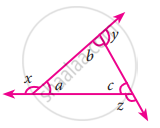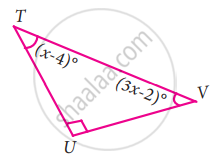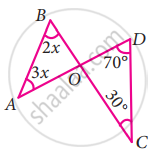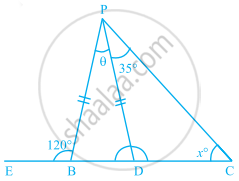Advertisements
Advertisements
प्रश्न
In the given figure, which of the following statement is true?
पर्याय
x + y + z = 180°
x + y + z = a + b + c
x + y + z = 2(a + b + c)
x + y + z = 3(a + b + c)
उत्तर
x + y + z = 2(a + b + c)
APPEARS IN
संबंधित प्रश्न
Find the value of the unknown x in the following diagram:

In the following triangle, find the value of x
Two line segments `bar("AD")` and `bar("BC")` intersect at O. Joining `bar("AB")` and `bar("DC")` we get two triangles, ∆AOB and ∆DOC as shown in the figure. Find the ∠A and ∠B
Angles of a triangle are in the ratio 2 : 4 : 3. The smallest angle of the triangle is ______.
In a triangle, one angle is of 90°. Then ______.
- The other two angles are of 45° each
- In remaining two angles, one angle is 90° and other is 45°
- Remaining two angles are complementary
In the given option(s) which is true?
In the given figure, PB = PD. The value of x is ______.

In ∆PQR, if PQ = QR and ∠Q = 100°, then ∠R is equal to ______.
In triangle XYZ, the measure of angle X is 30° greater than the measure of angle Y and angle Z is a right angle. Find the measure of ∠Y.
The angles of a triangle are arranged in descending order of their magnitudes. If the difference between two consecutive angles is 10°, find the three angles.
In ΔDEF, ∠D = 60°, ∠E = 70° and the bisectors of ∠E and ∠F meet at O. Find (i) ∠F (i) ∠EOF.
